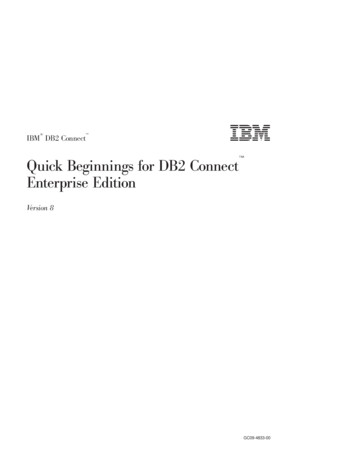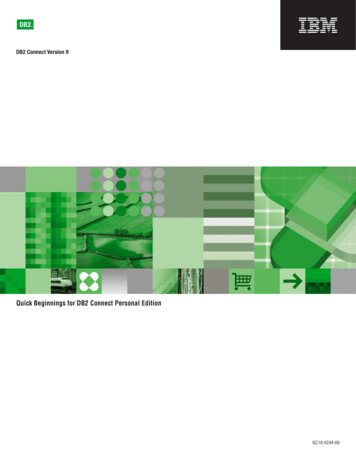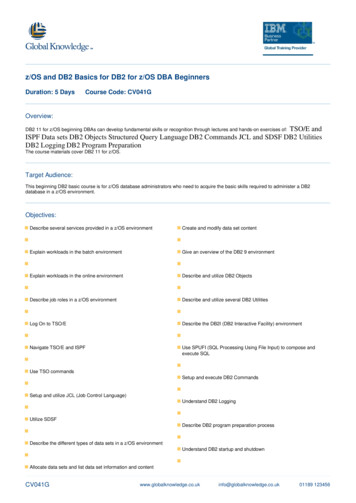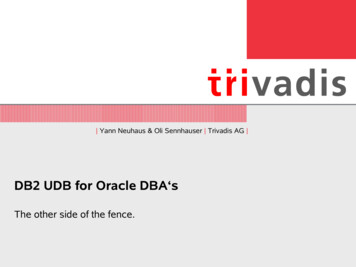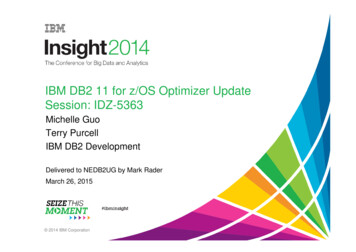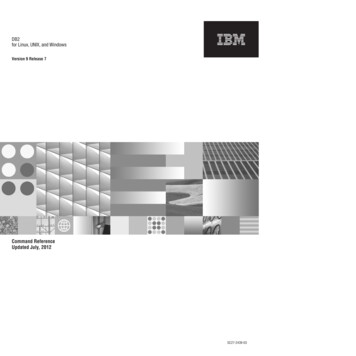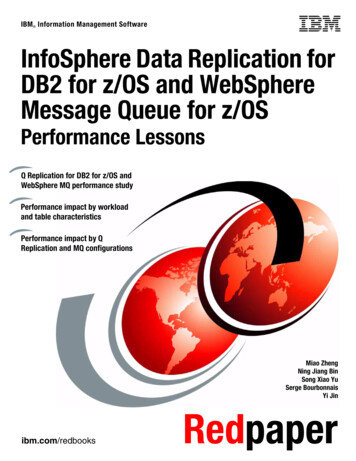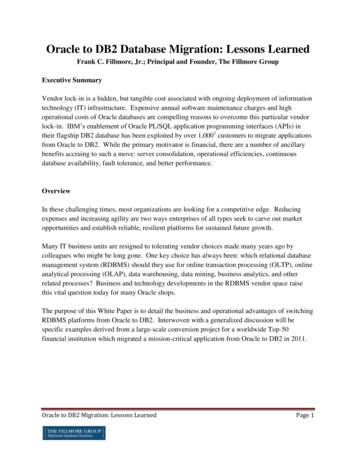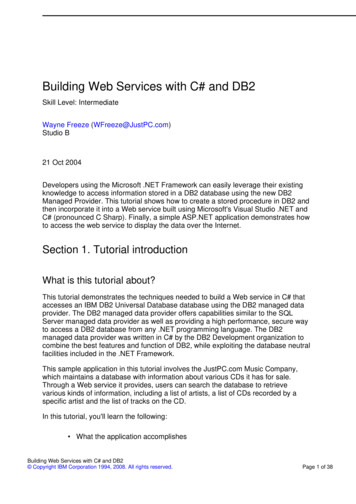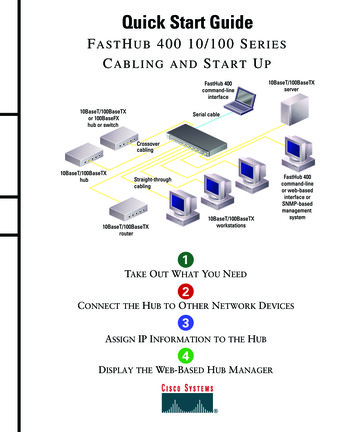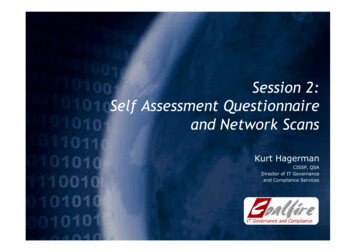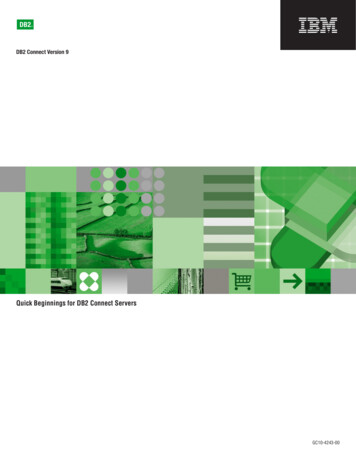
Transcription
DB2 DB2 Connect Version 9Quick Beginnings for DB2 Connect ServersGC10-4243-00
DB2 DB2 Connect Version 9Quick Beginnings for DB2 Connect ServersGC10-4243-00
Before using this information and the product it supports, be sure to read the general information under Notices.Edition NoticeThis document contains proprietary information of IBM. It is provided under a license agreement and is protectedby copyright law. The information contained in this publication does not include any product warranties, and anystatements provided in this manual should not be interpreted as such.You can order IBM publications online or through your local IBM representative.v To order publications online, go to the IBM Publications Center at www.ibm.com/shop/publications/orderv To find your local IBM representative, go to the IBM Directory of Worldwide Contacts at www.ibm.com/planetwideTo order DB2 publications from DB2 Marketing and Sales in the United States or Canada, call 1-800-IBM-4YOU(426-4968).When you send information to IBM, you grant IBM a nonexclusive right to use or distribute the information in anyway it believes appropriate without incurring any obligation to you. Copyright International Business Machines Corporation 1993, 2006. All rights reserved.US Government Users Restricted Rights – Use, duplication or disclosure restricted by GSA ADP Schedule Contractwith IBM Corp.
ContentsPart 1. Introduction to DB2 Connect1Chapter 1. About DB2 Connect . . . . . 3DB2 Connect product offerings . . . .Host and iSeries support for DB2 Connect. 3. 3Chapter 2. DB2 Connect scenarios . . . 5Accessing host or iSeries DB2 data using DB2Connect . . . . . . . . . . . . . . .Access DB2 data from remote clients . . . . .Accessing DB2 host data from the web using JavaManaging connections to databases using theConfiguration Assistant (Linux and Windows) . .Understanding the Administration Server . . .Administering instances and databases with theDB2 administration tools (Linux and Windows) .DB2 Client support for database applicationdevelopment . . . . . . . . . . . . .Installation requirementsproducts (AIX) . . .Installation requirementsproducts (HP-UX) . .Installation requirementsproducts (Linux) . . .Installation requirementsproducts (Solaris) . .for DB2. . .for DB2. . .for DB2. . .for DB2. . .Connect. . .Connect. . .Connect. . .Connect. . .server. . .server. . .server. . .server. . .39404141. 5. 910Chapter 10. Preparing Windows forLDAP . . . . . . . . . . . . . . . 43. 11. 12Chapter 11. Preinstallation tasks. . . . 45. 13. 15Part 2. Migrating DB2 Connect . . . 17Chapter 3. Migration to DB2 ConnectVersion 9 . . . . . . . . . . . . . . 19Extending the directory schema (Windows) .IBM Software Development Kit for Java levels forDB2 products . . . . . . . . . . . . .Kernel parameters (UNIX) . . . . . . . .Modifying kernel parameters (HP-UX) . . .Recommended kernel configuration parameters(HP-UX) . . . . . . . . . . . . .Modifying kernel parameters (Linux) . . . .Modifying kernel parameters (Solaris OperatingEnvironment) . . . . . . . . . . . . 43. 45. 46. 46. 46. 47. 48Chapter 12. Installation tasks . . . . . 51Chapter 4. Migration essentials for DB2Connect . . . . . . . . . . . . . . 21Chapter 5. Pre-migration tasks for DB2Connect servers . . . . . . . . . . 23Chapter 6. Migrating DB2 Connectservers . . . . . . . . . . . . . . 25Installing DB2 Connect (Windows) . . . . . .Installing a DB2 Connect server product(Windows). . . . . . . . . . . . . .Installing DB2 Connect (UNIX) . . . . . . . .Installing a DB2 Connect server product (AIX). .Installing a DB2 Connect server product (HP-UX)Installing a DB2 Connect server product (Linux)Preparing to install DB2 for Linux on zSeries . .Installing a DB2 Connect server product (Solaris)5151525254555657Chapter 7. Post-migration tasks forDB2 Connect servers . . . . . . . . 29Chapter 13. ID management . . . . . . 61Part 3. Installing DB2 Connect . . . 31Chapter 14. Postinstallation tasks . . . 63Chapter 8. Installation overview . . . . 33DB2 Connect server products: installation andconfiguration overview . . . . . . . . 33Chapter 9. Installation requirements . . 35Disk and memory requirements . . . . . . .Installation requirements (Windows) . . . . . .Installation requirements for DB2 Connect serverproducts (Windows) . . . . . . . . . .Required user accounts for installation of DB2server products (Windows) . . . . . . . .Installation requirements (UNIX) . . . . . . . Copyright IBM Corp. 1993, 2006353535Adding your user ID to the DB2ADMNS andDB2USERS user groups (Windows) . . . .Applying fix packs . . . . . . . . . . .DB2 Connect license activation . . . . . . .Registering a DB2 product or feature license keyusing the db2licm command . . . . . . .Registering a DB2 product or feature license keyusing the License Center . . . . . . . .Setting the DB2 license policy using the db2licmcommand . . . . . . . . . . . . .Setting the DB2 license policy using the LicenseCenter . . . . . . . . . . . . . . 61. 63. 64. 64. 65. 65. 663639iii
Part 4. Preparing host and iSeriesdatabases for DB2 Connectcommunications . . . . . . . . . . 67Chapter 15. Preparing DB2 for OS/390and z/OS databases for DB2 Connectcommunications . . . . . . . . . . 69Preparing DB2 Universal Database for OS/390 andz/OS for connections from DB2 Connect . . . . 69Configuring TCP/IP for DB2 Universal Database forOS/390 and z/OS . . . . . . . . . . . . 69Configuring DB2 Universal Database for OS/390and z/OS . . . . . . . . . . . . . . . 72Chapter 16. Preparing DB2 UDB foriSeries databases for DB2 Connectcommunications . . . . . . . . . . 73Preparing DB2 Universal Database for iSeries forconnections from DB2 Connect . . . . . . . 73Chapter 17. Preparing DB2 for VM &VSE databases for DB2 Connectcommunications . . . . . . . . . . 75Mounting the CD-ROMMounting the CD-ROMMounting the CD-ROMMounting the CD-ROMEnvironment) . . . .(AIX) . . . .(HP-UX) . . .(Linux) . . .(Solaris Operating. . . . . . 93. 94. 94. 95Chapter 24. Uninstalling DB2 Connect97Uninstalling your DB2 product (Windows) . . .Uninstalling your DB2 product (Linux and UNIX). 9798Part 8. Appendixes . . . . . . . . . 99Appendix A. Configuring and testingdatabase connections using theConfiguration Assistant . . . . . . . 101Configuring a database connection by searchingthe network using the Configuration Assistant . . 101Configuring a database connection manually usingthe Configuration Assistant . . . . . . . . . 102Testing a database connection using theConfiguration Assistant . . . . . . . . . . 103Appendix B. Language Support . . . 105Part 5. Configuring access to hostand iSeries databases . . . . . . . 77Changing the DB2 interface language (Windows)Changing the DB2 interface language (Linux andUNIX) . . . . . . . . . . . . . . .Supported DB2 interface languages . . . . .Language identifiers for running the DB2 Setupwizard in another language . . . . . . .Conversion of character data . . . . . . .Chapter 18. Using the ConfigurationAssistant . . . . . . . . . . . . . . 79Appendix C. DB2 Database technicalinformation . . . . . . . . . . . . 111Configuring a connection to host or iSeries databaseservers using the CA (Linux and Windows) . . . 79Overview of the DB2 technical information . . .Documentation feedback. . . . . . . . .DB2 technical library in hardcopy or PDF formatOrdering printed DB2 books . . . . . . . .Displaying SQL state help from the command lineprocessor . . . . . . . . . . . . . . .Accessing different versions of the DB2 InformationCenter . . . . . . . . . . . . . . . .Displaying topics in your preferred language in theDB2 Information Center . . . . . . . . . .Updating the DB2 Information Center installed onyour computer or intranet server . . . . . . .DB2 tutorials . . . . . . . . . . . . .DB2 troubleshooting information . . . . . . .Terms and Conditions . . . . . . . . . .Preparing DB2 for VSE & VM for connections fromDB2 Connect . . . . . . . . . . . . . . 75Chapter 19. Using the CLP . . . . . . 81Configuring a connection to host and iSeriesdatabase servers using the CLP . . . . . . 81Part 6. Using DB2 Connect . . . . . 83Chapter 20. Running your ownapplications . . . . . . . . . . . . 85Chapter 21. Binding database utilitieson DB2 Connect . . . . . . . . . . 87Chapter 22. Further reading . . . . . . 89105. 106. 107. 107. 108111111112114115116116117119119120Appendix D. Notices . . . . . . . . 121Trademarks . 123Part 7. Reference . . . . . . . . . 91Index . . . . . . . . . . . . . . . 125Chapter 23. Mounting the DB2 productCD . . . . . . . . . . . . . . . . 93Contacting IBMivDB2 Connect Servers Quick Beginnings. . . . . . . . . . 129
Part 1. Introduction to DB2 ConnectThe following section contains an overview of DB2 Connect , including examplesof different DB2 Connect environments. Topics discussed include:v Available versions of DB2 Connectv Suitability of each version for different business environmentsv Administration and client tools that work with DB2 Connectv How DB2 Connect relates to Java , web applications, and transaction processingscenariosWho Should Read This Sectionv Managers exploring how to integrate DB2 Connect with present or plannedbusiness operationsv Technical staff preparing to install DB2 Connect Copyright IBM Corp. 1993, 20061
2DB2 Connect Servers Quick Beginnings
Chapter 1. About DB2 ConnectDB2 Connect provides connectivity to mainframe and midrange databases fromLinux , UNIX , and Windows based platforms. You can connect to DB2 databases on OS/390 and z/OS , iSeries , VSE, and VM. You can also connect tonon-IBM databases that comply with the Distributed Relational DatabaseArchitecture (DRDA ).DB2 Connect product offeringsDB2 Connect has several connection solutions, including DB2 Connect PersonalEdition, and a number of DB2 Connect server products:v DB2 Connect Enterprise Editionv DB2 Connect Application Server Editionv DB2 Connect Unlimited Edition for zSeries v DB2 Connect Unlimited Edition for iSeriesFor detailed information about DB2 Connect product offerings, seehttp://www.ibm.com/support/docview.wss?rs 73&uid swg21219983Related tasks:v “Installing a DB2 Connect server product (AIX)” on page 52“Installing a DB2 Connect server product“Installing a DB2 Connect server product“Installing a DB2 Connect server product“Installing a DB2 Connect server product“Installing DB2 Connect Personal EditionConnect Personal Editionv “Installing DB2 Connect Personal EditionDB2 Connect Personal Editionvvvvv(HP-UX)” on page 54(Linux)” on page 55(Solaris)” on page 57(Windows)” on page 51(Linux)” in Quick Beginnings for DB2(Windows)” in Quick Beginnings forHost and iSeries support for DB2 ConnectDB2 Connect supports connectivity to the following host and iSeries data servers:Table 1. Supported host and iSeries data serversVersionRecommended Service Upgrade (RSU)DB2 UDB for OS/390 and z/OSVersion 7.1RSU0606DB2 UDB for z/OS Version 8See vicetst/RSU0606See vicetst/ Copyright IBM Corp. 1993, 20063
Table 1. Supported host and iSeries data servers (continued)VersionRecommended Service Upgrade (RSU)DB2 UDB for iSeries V5R1, V5R2 , II13348 (Informational APAR)V5R3, and V5R4For iSeries Preventative Service Planning, seehttp://www-912.ibm.com/s dir/sline003.NSF/GroupPTFs?OpenView&view GroupPTFsDB2 Server for VM/VSE Version 7 See http://www.ibm.com/software/data/db2/vseand latervm/support/dwnldsfs.htmlDetailed prerequisite information is available at:http://www-1.ibm.com/support/docview.wss?rs 71&context SSEPGG&dc D600&uid swg21233566Related concepts:v “DB2 Connect” in DB2 Connect User’s Guidev “Accessing host or iSeries DB2 data using DB2 Connect” on page 5Related tasks:v “Configuring a connection to host or iSeries database servers using the CA(Linux and Windows)” on page 79Related reference:v “Host databases” in DB2 Connect User’s Guide4DB2 Connect Servers Quick Beginnings
Chapter 2. DB2 Connect scenariosAccessing host or iSeries DB2 data using DB2 ConnectA DB2 Connect server enables DB2 clients on a LAN access to data that is storedon host or iSeries systems.In organizations with large amounts of data, DB2 UDB for iSeries, DB2 UDB forOS/390 and z/OS, or DB2 Server for VSE & VM are commonly used to managethat data. Applications that run on any of the supported platforms can work withthis data transparently, as if a local database server managed it. A DB2 Connectserver product, such as DB2 Connect Enterprise Edition, is required for supportingapplications which access host or iSeries data and exploit transaction monitors aswell as applications that are implemented as Java applets.In addition, you can use a wide range of off-the-shelf or custom-developeddatabase applications with DB2 Connect and its associated tools. For example, youcan use DB2 Connect products with:v Spreadsheets, such as Microsoft Excel and Lotus 1-2-3 , to analyze real-timedata without having the cost and complexity of data extract and importprocedures.v Decision support tools, such as BusinessObjects, Brio and Impromptu, and CrystalReports, to provide real-time information.v Database products, such as Lotus Approach and Microsoft Access.v Development tools, such as PowerSoft PowerBuilder, Microsoft Visual Basic, andBorland Delphi, to create client/server solutions.A DB2 Connect server product, such as DB2 Connect Enterprise Edition, is mostappropriate for environments where:v Application is implemented using data-aware Java applets (see Figure 5 on page11).v Web servers are used to implement web-based applications (see Figure 4 on page9 and Figure 5 on page 11).v Middle-tier application server is employed.v Transaction monitors such as IBM TXSeries CICS and Encina Monitor,WebSphere Application Server, WebSphere MQ, Microsoft Transaction Server(MTS), and BEA Tuxedo are used. (See Figure 2 on page 7.)DB2 Connect provides transparent access to host or iSeries data through a standardarchitecture for managing distributed data. This standard is known as DistributedRelational Database Architecture (DRDA). DRDA allows your applications toestablish a fast connection to host and iSeries databases without expensive host oriSeries components or proprietary gateways.Although DB2 Connect is often installed on an intermediate server machine toconnect DB2 clients to a host or iSeries database, it is also installed on machineswhere multiple local users want to access the host or iSeries servers directly. Forexample, DB2 Connect can be installed on a large machine with many local users. Copyright IBM Corp. 1993, 20065
DB2 Connect can also be installed on a Web server, Transaction Processor (TP)monitor, or other 3-tier application server machines with multiple local SQLapplication processes and threads. In these cases, you can choose to install DB2Connect on the same machine for simplicity, or on a separate machine to off-loadCPU cycles.A DB2 Connect server enables multiple clients to connect to host or iSeries dataand can significantly reduce the effort that is required to establish and maintainaccess to enterprise data. Figure 1 illustrates IBM’s solution for environmentswhere a DB2 client makes an indirect connection to a host or iSeries databaseserver through a DB2 Connect server product.To connect to an IBM host or iSeries database server you require a licensed DB2Connect product. You cannot connect directly to an IBM host or iSeries Data Serverusing a DB2 client.Figure 1. Connecting a client to a host or iSeries data server using DB2 Connect6DB2 Connect Servers Quick Beginnings
Figure 2. Transaction monitors working with DB2 Connect.Chapter 2. DB2 Connect scenarios7
Figure 3. WebSphere and Java server functionality in DB2 Connect8DB2 Connect Servers Quick Beginnings
Figure 4. DB2 Connect working with Microsoft Internet Information Server (IIS)Related concepts:v “DB2 Connect server products: installation and configuration overview” on page33Related reference:v “DB2 Connect product offerings” on page 3Access DB2 data from remote clientsDB2 clients provide a run-time environment that enables client applications toaccess one or more remote databases. With the DB2 client, you can remotelyadminister DB2 or DB2 Connect servers. All applications must access a databasethrough the DB2 client. A Java applet can access a remote database through aJava-enabled browser.The DB2 client is supported on Linux, UNIX, and Windows platforms.Related concepts:Chapter 2. DB2 Connect scenarios9
v “DB2 client setup overview” in Quick Beginnings for DB2 Clientsv “Types of clients - DB2 Runtime Client and DB2 Client” in Quick Beginnings forDB2 ClientsAccessing DB2 host data from the web using JavaDB2 Connect products include the IBM DB2 Driver for JDBC and SQLJ to allowyou to create applications that access data in DB2 databases from the Web.Programming languages containing embedded SQL are called host languages. Javadiffers from the traditional host languages C, COBOL, and FORTRAN, in waysthat significantly affect how it embeds SQL:v SQLJ and JDBC are open standards, enabling you to easily port SQLJ or JDBCapplications from other standards-compliant database systems to the DB2database.v All Java types representing composite data, and data of varying sizes, have adistinguished value, null, which can be used to represent the SQL NULL state,giving Java programs an alternative to NULL indicators that are a fixture ofother host languages.v Java is designed to support programs that, by nature, are heterogeneouslyportable (also called ″super portable″ or simply ″downloadable″). Along withJava’s type system of classes and interfaces, this feature enables componentsoftware. In particular, an SQLJ translator written in Java can call componentsthat are specialized by database vendors in order to leverage existing databasefunctions such as authorization, schema checking, type checking, transactional,and recovery capabilities, and to generate code optimized for specific databases.v Java is designed for binary portability in heterogeneous networks, whichpromises to enable binary portability for database applications that use staticSQL.v You can run JDBC applets inside a web page on any system with a Java-enabledbrowser, regardless of the platform of your client. Your client system requires noadditional software beyond this browser. The client and the server share theprocessing of JDBC and SQLJ applets and applications.10DB2 Connect Servers Quick Beginnings
Figure 5. JDBC and DB2 ConnectJDBC and SQLJ applications can be run from any system that has a DB2 clientinstalled; a Web browser and a Web server are not required.For more information on the JDBC API, see the http://java.sun.com/products/jdbc/ web page.Related concepts:v “Managing connections to databases using the Configuration Assistant (Linuxand Windows)” on page 11v “Supported drivers for JDBC and SQLJ” in Developing Java ApplicationsManaging connections to databases using the Configuration Assistant(Linux and Windows)The Configuration Assistant (CA) helps you manage your database connections toremote servers. The CA is available as part of the DB2 client. The CA is thepreferred method to set up any client to server communications.Chapter 2. DB2 Connect scenarios11
Note: In previous releases, the DB2 Administration Tools, such as the CA, weresupported on all platforms. As of Version 9, the DB2 Administration Toolsare supported only on Windows x86, Windows x64 (AMD64/EM64T), Linuxon x86, and Linux on AMD64/EM64T. For all platforms, you can use theDB2 command line processor (CLP) to manage connections.With the CA, you can:v Catalog databases so that they can be used by applications. Three methods areavailable:– Use a profile provided by a database administrator to automatically defineyour connections. Client access is automatically set up for that database.– Search the network for available databases and select one. Client access isautomatically set up for those databases defined in the profile. DB2 ConnectPersonal Edition cannot search for host or iSeries databases except through aDB2 Connect server that has host or iSeries databases defined.– Manually configure a connection to a database by entering the requiredconnection parameters.v Remove cataloged databases, or change the properties of a cataloged database.v Export and import client profiles that contain database and configurationinformation for a client.v Test connections to local or remote databases identified on your system.v Bind applications to a database by selecting utilities or bind files from a list.v Add, change, remove CLI/ODBC data sources, and configure CLI/ODBCconfiguration settings.v Tune the client configuration parameters on your system. Parameters arelogically grouped and suggested settings are provided on the interface asparameters are selected.v Update the database server password.Related concepts:v “Client-to-server communications configuration overview” in Quick Beginningsfor DB2 ClientsRelated tasks:v “Configuring a database connection manually using the Configuration Assistant”on page 102v “Configuring database connections using a client profile with the ConfigurationAssistant” in Quick Beginnings for DB2 Clientsv Chapter 21, “Binding database utilities on DB2 Connect,” on page 87v “Configuring a connection to host or iSeries database servers using the CA(Linux and Windows)” on page 79Understanding the Administration ServerThe DB2 Administration Server (DAS) responds to requests from the DB2Administration Tools and the Configuration Assistant (CA). The DB2Administration Tools, for example, allow you to start, stop, and set databasemanager configuration parameters for servers. The Administration Server is usedby the CA to help users catalog databases on a client. The DAS is available on allsupported Linux, Windows, and UNIX operating systems as well as the zSeries(OS/390 and z/OS only) operating systems.12DB2 Connect Servers Quick Beginnings
An Administration Server must reside on each server that you want to administerand detect. The Administration Server is automatically created and started for you.The setup program creates the Administration Server on the instance-owningmachine and automatically starts it at boot time. By default the DAS instance isDB2AS, which is the default user ID that is created using the DB2 Setup wizard.Related concepts:v “DB2 Administration Server” in Administration Guide: ImplementationRelated tasks:v “Creating a DB2 administration server (DAS)” in Administration Guide:ImplementationAdministering instances and databases with the DB2 administrationtools (Linux and Windows)You can administer local or remote servers using the DB2 administration tools. Usethe Control Center to perform administration tasks such as configuring DB2instances and databases, backing up and recovering data, scheduling jobs, andmanaging media, all from a graphical interface.Note: In previous releases, the DB2 Administration Tools, such as the ControlCenter, were supported on all platforms. As of Version 9, the DB2Administration Tools are supported only on Windows x86, Windows x64(AMD64/EM64T), Linux on x86, and Linux on AMD64/EM64T. For allplatforms, you can use the DB2 command line processor (CLP) to administerinstances and databases.The Control Center has support for the following products:v DB2 UDB for OS/390 and z/OS Version 7v DB2 UDB for z/OS Version 8The remainder of this topic will refer collectively to these products as DB2 UDB forz/OS, unless the content is version specific.If you want to access DB2 UDB for z/OS functions from the Control Center:1. Verify that:v You have a DB2 UDB for z/OS licensev You have a DB2 Connect product installed on the client workstationv Distributed Data Facility (DDF) is started at the hostv The DB2 subsystem is cataloged on the clientv The DB2 Connect utilities and the DB2 CLI are bound to the host2. Apply the FMIDs for the DB2 Management Clients Package (a feature of DB2UDB for z/OS) and DB2 Administration Server (DAS) for OS/390 and z/OS.DAS is an optional feature that is shipped with DB2 for OS/390 and z/OSserver. Read the DB2 UDB for z/OS, DB2 Management Clients Package, andDB2 Administration Server for OS/390 and z/OS program directories. Theprogram directory identifies and describes the contents of FMIDs for each tapeor cartridge. The program directory also provides the installation requirementsand instructions.3. Apply any additional service to DB2 UDB for z/OS as described in theprogram directories.Chapter 2. DB2 Connect scenarios13
4. The DB2 Control Center provides support to help you manage DB2 databaseson multiple platforms. When managing DB2 UDB for z/OS subsystems, youneed to install a set of stored procedures, user defined functions, and batchprograms for each DB2 subsystem:DB2 UDB for z/OS Version 8If you have DB2 UDB for z/OS Version 8 installed, you need to installthe z/OS enablement feature (JDB881D).DB2 UDB for OS/390 and z/OS Version 7If you have DB2 UDB for OS/390 and z/OS Version 7 installed, youneed to install the 390 enablement feature (JDB771D).If you want to fully exploit all the DB2 Control Center functions for DB2 UDBfor z/OS, including Cloning and JCL building and creation, you need to installthe DB2 Administration Server (DAS) for OS/390 and z/OS Version 8(HDAS810) which ships as a feature of DB2 UDB for z/OS.Notes:a. FMID JDB881D or JDB771D needs to be installed on every DB2 subsystemthat you want to work with using the Control Center.b. FMID HDAS810 needs to be installed only once per image of the operatingsystem or LPAR where you have DB2 subsystems that you want to workwith using Control Center.c. Instructions for the various installations can be found in the ProgramDirectory within the DB2 Management Clients Package of the appropriateproduct and version. For example, instructions for installing the DAS(HDAS810) are in the Program Directory for IBM DB2 UDB for z/OS DB2Management Clients Package Version 8.d. The DB2 Administration Server only needs to be installed once per system.5. Ensure that you enabled the stored procedures address space.6. Ensure that the DB2 Administration Server is started.Detailed instructions for enabling the Control Center to work with DB2 UDB forz/OS exists at:http://www.ibm.com/support/docview.wss?rs 64&context SSEPEK&q1 jdb881d&uid swg27006262Managing communications on the server:The Control Center allows you to view, update, and reset server protocol settingsin the database manager configuration file. These functions are accessed by clickingwith the right mouse button on an instance and selecting the Setupcommunications option from the pop-up menu. By default, the setup programautomatically detects and configures most communication protocols that it detectson your system.You can also perform the following operations with the Control Center:v Configure database manager parameters by clicking with the right mouse buttonon an instance and selecting the Configure option from the pop-up menu.v Export database information in a profile that can be used to configure clients byclicking with the right mouse button on a system and selecting the ExportServer Profile option from the pop-up menu.Viewing SQL access plans using Visual Explain:14DB2 Connect Servers Quick Beginnings
You cannot use Visual Explain to generate access plans on host or iSeriesdatabases.Visual Explain helps database administrators and application developers to:v View the access plan chosen by the database manager’s optimizer for a givenSQL statement.v Tune SQL statements for better performance.v Design application programs and databases.v View all the details of an access plan, including the statistics in the systemcatalogs.v Decide whether or not to add an index to a table.v Identify the source of problems by analyzing the access plan or performance ofSQL statements.v Use the portable snapshot function to view snapshots from any remote DB2server.v Display access plans for queries on all supported DB2 configurations.Related tasks:v Chapter 21, “Binding database utilities on DB2 Connect,” on page 87DB2 Client support for database application developmentThere are two DB2 clients: the DB2 Client; and the DB2 Runtime Client. Of thetwo, only the DB2 Client is suitable for database application development.The DB2 Client includes the following:v Precompilers for C/C , COBOL, and Fortran, (providing the language issupported for that platform).v Embedded SQL application support, including programming libraries, includefiles and code samples.v ODBC and DB2 Call Level Interface (DB2 CLI) application support, includingprogramming libraries, include files, and code samples for developingapplications which are easily ported to ODBC and compiled with an ODBCSDK. An ODBC SDK is available from Microsoft for Windows operatingsystems, and from various other vendors for many of the other supportedplatforms. On Windows operating systems, the ODBC and CLI driver is installedby default with the DB2 Client, supporting applications developed with theMicrosoft ODBC Software Developer’s Kit. For all other platforms, the ODBCand CLI driver can optionally be installed with the DB2 Client, supportingapplications that can be developed with an ODBC SDK for that platform, if oneexists.v The IBM DB2 Driver for JDBC and SQLJ, which includes:– JDBC support, for developing Java applications with dynamic SQL– SQLJ support, for developing Java applications with static SQLv An SDK for Java is shipped with DB2 clients for all supported operatingsystems.v ActiveX Data Objects (ADO) and Object Linking and Embedding (OLE)automation routines (UDFs and Stored Procedures) on Windows operatingsystems, including code samples implemented in Microsoft Visual Basic andMicrosoft Visual C . Also, code samples with Remote Data Objects (RDO)implemented in Microsoft Visual Basic.Cha
communications.67 Chapter 15. Preparing 97 DB2 for Chapter OS/390 24. and z/OS Uninstalling . Personal Edition (Windows)” . access host or iSeries data and exploit transaction monitors as well
